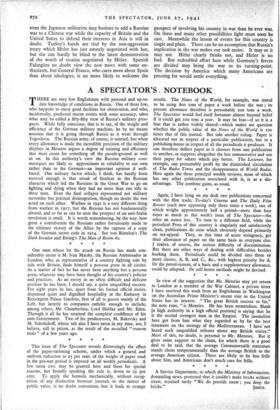This issue of The Spectator reveals distressingly the effect of
the paper-rationing scheme, under which a general and uniform reduction to 25 per cent. of the weight of paper used in the pre-war period is imposed on all weekly periodicals. A few extra cwt. may be granted here and there for special reasons, but broadly speaking the rule is, down to 25 per cent. To apply the formula mechanically, without recog- nition of any distinction between journals in the matter of public value, is no doubt convenient, but it leads to strange results. The News of the World, for example, was stated to be using Boo tons of paper a week before the war ; its present allowance therefore is presumably zoo tons a week. The Spectator would feel itself fortunate almost beyond belief if it could get zoo tons a year. It may be bias—if so it is a bias that is rather widely shared—which makes me question whether the public value of the News of the World is too times that of this journal. But take another ruling. Paper is allocated not in respect of a particular publication, but to a publishing-house in respect of all the periodicals it produces. It can therefore deflect paper as it chooses from one publication to another, or suppress altogether the less remunerative and use their paper for others which pay better. The Listener, for example, can presumably profit by the diminished circulation of The Radio Times and the disappearance of World Radio. Here again the three principal weekly reviews, none of which has any other publication associated with it, is at a dis- advantage. The combine gains, as usual.






















 Previous page
Previous page